How to draw horse eyes part (2): close-up detail
September 17, 2012
A closer look at the horse’s eye
Above: a sensitive photo of “Oso”by Shelley Liddell
When is it useful to draw the eye in detail?
In most situations, the general shadow-shape of the eye is almost all that you need when drawing a horse. For advice for artists on the shape and position of the horse’s eyes, click here.
If you are commissioned to draw a portrait of a horse’s head, you will probably be expected to draw or paint the eyes in loving detail. The shape of the lids, the colour of the eyes and lashes and the expression within the eyes all help in achieving a “likeness”. While horses may communicate with one another more with their ears and general body language, it is the eyes that have an emotional “hold” over us humans, so it is as well to get good at drawing them.
In this post, I explain the structure of the horse eye as seen close up. In the next post I shall discuss equine eyes, mood and expression.
Visible parts of the eye
I have labelled a photo to show parts of the eye that equine artists should know about:
The dark central pupil is round in foals but becomes horizontal and rather oblong as the horse matures.
The iris fills most of the visible eye and is usually brown. If drawing in preparation for a close-up portrait, pay attention to its exact colour and make good sketchbook notes e.g. dark chocolate brown or hazel brown. There may be beautiful freckles of darker pigment within the iris, as here. Notice also how the iris is a richer, darker colour around its edge.
The sclera is the white of the eye and may be just visible, in some horses, as a rim of white around the iris.
The upper eyelashes are very prominent. Notice their length and colour when drawing a portrait.
The third eyelid is a whitish membrane that may be just visible at the inner corner of the eye. Note, also, the tiny bit of glistening pink “mucosa” membrane that may also be visible within the inner corner of the eye.
In my experience, the upper and lower eyelids themselves do not vary much in shape from horse to horse. However, do pay attention to any colours that you see when drawing a portrait as this will mean a lot to the horse’s owner. For example, some light grey (almost white) or palomino horses have dark grey upper and/or lower eyelids.
In looking at your horse’s eyes close up, you may some brownish shapes over the top edge of the pupil (see below). These are called either corpora nigra or granula iridica and are usually just normal pigment. In the photo below, someone is lifting the upper eyelid for a better look at the eye, which is why we are seeing so much of the white sclera at the top.
Shape of upper lid and eyebrow
I find the following drawing useful in understanding the shape of the eyelids. It is a detail from plate 9 of “An atlas of animal anatomy for artists” by Ellenberger et. al. Do please ignore the pencil scrawl that I had added to my book:
See how the upper eyelid protrudes and curves over the eye. Notice also how the eyelid has an appreciable thickness. Its free edge is rather rounded and does not appear sharply sheared-off. The graduated highlight on the upper lid helps to describe its shape.
The diagram above also shows how the eye is set under the prominent “eyebrow”. In this case, the brow is formed of muscle in the shape of an upside-down “U”. Horse eyebrows change shape with expression and sometimes look far more pointy than this. Notice how the three-dimensional roundness and structure of the brow is clearly shown here using tonal shadows and higlights.
The roundness of the eye surface
Here is a front view of a horse eye to show how rounded the eye surface is:
The eye surface curves like the surface of a ball or sphere. Notice how much (or little) of the eye is visible from the front view, as part of the “eyebrow” curves in front of it.
The lower eyelid
The lower lid clings closer to the surface of the eye than the upper lid and juts out far less. Take a look at this almost-frontal view of Moonie’s right eye:
From some angles, you will see the free edge of the lower lid as a dark-coloured shiny membrane., and there may be an obvious bright highlight along this edge:
There are no true eyelashes from the lower eyelid. However, there are often some long whiskery hairs that emerge from the skin below the eye, and sometimes other whiskers above the eye as well. The position and colour of these are very specific to each horse, so be sure to make a note of them if you are commissioned to draw a close-up equine portrait. These whiskers may catch the light and become very prominent:
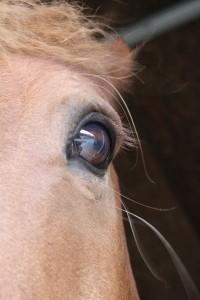
The lower lid is wider at the front (i.e. closer to the “inner corner” of the eye). Here is a side view of the horse, “William”, with his nose positioned to the left side of the photo.:
Highlights and reflections on the eye surface
The surface of the horse’s eye is shiny like a mirror. Amazingly, you often see a complex mirror image of the horse’s surroundings reflected in the eye. This reflection may well include you, the artist, as a dark shape. This can be very confusing, but here are some tips:
- If you insist on working from a close-up photo, be aware that the photographer and camera may be visible in the photo as a mirror image in the eye.
- Do not work from a flash photo of the eye. The flash will completely alter the appearance of eye-surface reflections. It also makes the pupil appear white, and it “flattens” the appearance of the lids by reducing tonal contrast. To avoid using flash, bring the horse outdoors if possible and adjust your camera settings if required. You may need to use a higher ISO setting and shallower depth of field (lower F-stop number) to get the effect that you want.
- Any eye-surface highlights and reflections are curved. This is because the eye’s surface is curved:
- Simplify the reflection in your drawing to some extent. If sky is behind me, I often see a horizontal band of highlight curved over the upper part of the eye. Look closely and mark the shape and position of the main highlight in to start with. You can always add more detail later.
- Any highlight or reflection will extend smoothly over the eye surface (over the black pupil, brown iris and white sclera). It does not stop suddenly at the edge of the pupil or at the edge of the iris.
- The highlight makes the pupil, iris and sclera lighter in tone. It is easy to appreciate a bright highlight over the dark pupil and iris. But the highlight can extend over the sclera, the “white of the eye” too. Most of the sclera is actually off-white (slight bluish or yellowish grey) and a bright highlight extending over it will be lighter in tone than the rest.
- Don’t get too worried about the exact colour of highlights, but do notice whether the highlights are “warm” (yellowish) or “cool” (bluish) in colour. Make good sketchbook notes with the horse in front of you, as you will not get that information reliably from a photo.
- How bright (light in tone) are the highlights? Again, do make good sketchbook notes.
- Some of the reflections on the eye surface are dark shapes. You may see yourself reflected (!) or the dark shape of a building behind you. Decide how much or little of this detail to include. It is your choice. Below is a photo that I have taken of Moonie the pony. If you look closely, you can see me, my camera and much of the stable yard reflected in the eye surface.
Eyelashes
Eyelashes emerge from the upper, not lower, eyelid. Think of the whole set of lashes as one structure to start with. Look back at the eye photos in this article, and notice how they emerge from around the upper edge of the upper eyelid. There is a little gap between the surface of the eye and the point where the eyelashes emerge.
If working towards a horse portrait, do take careful note of the colour, length and general direction of the lashes.
The eyelashes are often lighter in tone than the eye itself. That means that they need to be planned for if working in a translucent medium from light to dark, e.g. watercolour. Don’t just put them in as an after-thought.
Going about drawing horse eyes….some thoughts
When sketching horse eyes from life, you need to be particularly patient. The appearance of the eye changes completely as the horse turns his head and even as he thinks a new thought! I suggest embarking on several sketches per page. Move from one drawing to another, and back again, as the horse moves his head. Here is a spread from my sketchbook:
To see eye detail, you need to be near the horse. If you then extend your drawing (from the same viewpoint) to include more of the horse’s head, remember to take foreshortening into account. This can be a surprising challenge. If you can’t see all of the horse’s head without moving your own eyes, then your picture will be distorted:
Do step back now and again and make sketches of the whole head and neck, indicating the general shape of the eye without any detail. The size of the eye compared with the head, and the distance between eye and mouth, are important in achieving a “likeness”.
Drawing horse eyes from life is a big challenge. If you are working towards an equine portrait, spend a couple of hours sketching the head from several angles and from near and far, draw features close-up and make notes that you yourself understand about colours, etc. By all means do take flash-free photos to supplement your sketches, but don’t rely rigidly on any one photo.
In most horse pictures, details such as individual eyelashes will not be visible. What you do see are shapes suggesting the highlighted curve of an eyelid, a swathe of eyelashes and perhaps a carefully-placed highlight. Below I have reproduced horse heads from celebrated equine paintings. It is surprising how little eye detail has been used:
Above: Detail from Edwin Landseer’s “The Arab Tent”
Above: Detail from Paulus Potter’s “The Piebald Horse”, 1650-4
Above: Detail from Auguste Renoir’s “Horsewoman in the Bois de Boulogne”
Above: Detail from Rosa Bonheur’s “The Horse Fair” ,1853-5
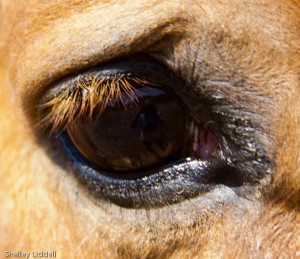
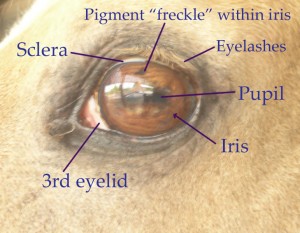
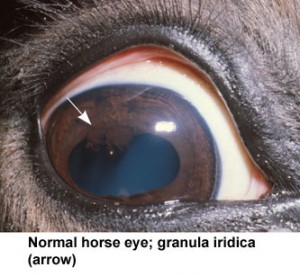
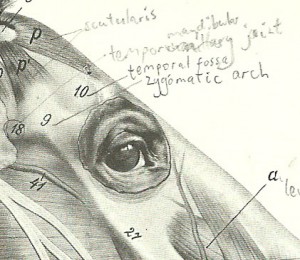
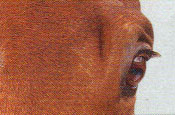
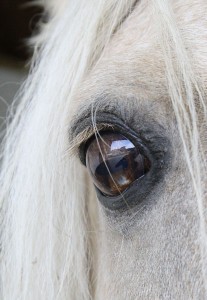
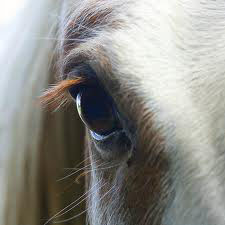




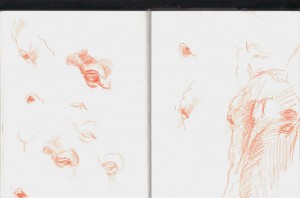
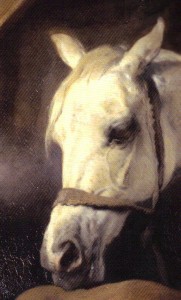
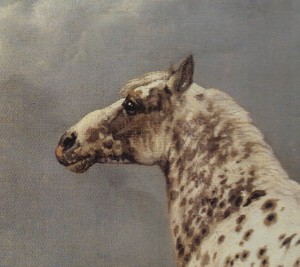

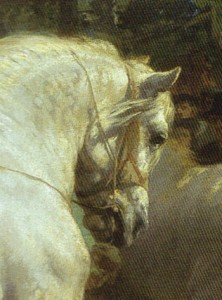
Dear Marianne
I am not a horse person, but I love their expressive faces. I am an amateur trying to secretly oil paint a friend’s thoroughbred racehorce that has just finished his racing career here in Perth Western Australia. Unfortunately the picture that I am working from is only 64Kb so the definition is not precise. I realise that the eyes are so expressive and they are not the same as a human’s so I found your description to be quite refreshing. I sincerely thank you for your website and will persevere with your instruction to achieve a reasonable representation of this lovely animal. Have a great Christmas and may your New Year be healthy and fruitful. Bevan D Marshall
Dear Bevan, Thanks for your kind words. You know how you can sometimes recognise a particular horse (or person) from halfway across a field? Sometimes, to get a good likeness, the whole shape and posture of the head and neck are more important than the detail in the eyes. Things to look for in your low-resolution photo include the shape of the ears (how long are they, and how are they positioned?) the angle of the head compared with the neck and, if the photo is clear enough, some of the bolder shadows and ridges around the eyes. If all else fails, then you’ll have to go and meet the horse (in secret!) and take your own photos. Good luck!